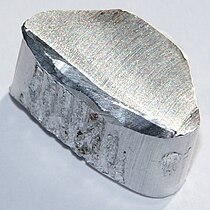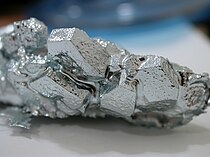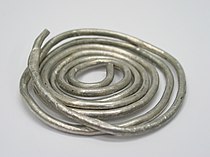
A | B | C | D | E | F | G | H | CH | I | J | K | L | M | N | O | P | Q | R | S | T | U | V | W | X | Y | Z | 0 | 1 | 2 | 3 | 4 | 5 | 6 | 7 | 8 | 9
| Boron group (group 13) | |||||||||||
|---|---|---|---|---|---|---|---|---|---|---|---|
| |||||||||||
| ↓ Period | |||||||||||
| 2 | Boron (B) 5 Metalloid | ||||||||||
| 3 | Aluminium (Al) 13 Other metal | ||||||||||
| 4 | Gallium (Ga) 31 Other metal | ||||||||||
| 5 | Indium (In) 49 Other metal | ||||||||||
| 6 | Thallium (Tl) 81 Other metal | ||||||||||
| 7 | Nihonium (Nh) 113 other metal | ||||||||||
|
Legend
| |||||||||||
The boron group are the chemical elements in group 13 of the periodic table, consisting of boron (B), aluminium (Al), gallium (Ga), indium (In), thallium (Tl) and nihonium (Nh). This group lies in the p-block of the periodic table. The elements in the boron group are characterized by having three valence electrons.[1] These elements have also been referred to as the triels.[a]
Several group 13 elements have biological roles in the ecosystem. Boron is a trace element in humans and is essential for some plants. Lack of boron can lead to stunted plant growth, while an excess can also cause harm by inhibiting growth. Aluminium has neither a biological role nor significant toxicity and is considered safe. Indium and gallium can stimulate metabolism;[3] gallium is credited with the ability to bind itself to iron proteins. Thallium is highly toxic, interfering with the function of numerous vital enzymes, and has seen use as a pesticide.[4]
Characteristics
Like other groups, the members of this family show patterns in electron configuration, especially in the outermost shells, resulting in trends in chemical behavior:
| Z | Element | No. of electrons per shell |
|---|---|---|
| 5 | boron | 2, 3 |
| 13 | aluminium | 2, 8, 3 |
| 31 | gallium | 2, 8, 18, 3 |
| 49 | indium | 2, 8, 18, 18, 3 |
| 81 | thallium | 2, 8, 18, 32, 18, 3 |
| 113 | nihonium | 2, 8, 18, 32, 32, 18, 3 (predicted) |
The boron group is notable for trends in the electron configuration, as shown above, and in some of its elements' characteristics. Boron differs from the other group members in its hardness, refractivity and reluctance to participate in metallic bonding. An example of a trend in reactivity is boron's tendency to form reactive compounds with hydrogen.[5]
Although situated in p-block, the group is notorious for violation of the octet rule by its members boron and (to a lesser extent) aluminium. All members of the group are characterized as trivalent.
Chemical reactivity
Hydrides
Most of the elements in the boron group show increasing reactivity as the elements get heavier in atomic mass and higher in atomic number. Boron, the first element in the group, is generally unreactive with many elements except at high temperatures, although it is capable of forming many compounds with hydrogen, sometimes called boranes.[6] The simplest borane is diborane, or B2H6.[5] Another example is B10H14.
The next group-13 elements, aluminium and gallium, form fewer stable hydrides, although both AlH3 and GaH3 exist. Indium, the next element in the group, is not known to form many hydrides, except in complex compounds such as the phosphine complex H3InP(Cy)3 (Cy=cyclohexyl).[7] No stable compound of thallium and hydrogen has been synthesized in any laboratory.
| Some common chemical compounds of the boron group[5] | |||||
|---|---|---|---|---|---|
| Element | Oxides | Hydrides | Fluorides | Chlorides | Sulfides |
| Boron | (β/g/α)B2O3 | B2H6 | BF3 | BCl3 | B2S3 |
| B2O | B10H14 | BF− 4 |
|||
| B6O | BH3 | B2F4 | |||
| B5H9 | BF | ||||
| B6H12 | |||||
| B4H10 | |||||
| B 6H2− 6 |
|||||
| B 12H2− 12 |
|||||
| B20H26 | |||||
| Aluminium | (γ/δ/η/θ/χ)Al2O3 | (α/α`/β/δ/ε/θ/γ) AlH3 | AlF3 | AlCl3 | (α/β/γ) Al2S3 |
| Al2O | Al2H6 | ||||
| AlO | AlH4 | ||||
| AlH− 4 |
|||||
| Gallium | (α/β/δ/γ/ε) Ga2O3 | Ga2H6 | GaF3 | GaCl3 | GaS |
| GaH4 | GaCl2 | ||||
| GaH3 | Ga2Cl4 | ||||
| Ga2Cl6 | |||||
| GaCl− 4 |
|||||
| Ga 2Cl− 7 |
|||||
| Indium | In2O3 | InH3 | InF3 | InCl3 | (α/β/γ) In2S3 |





